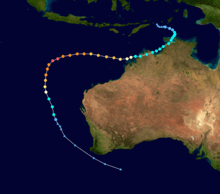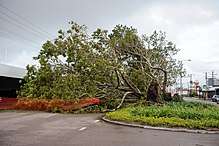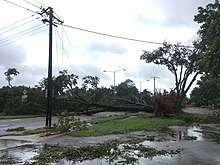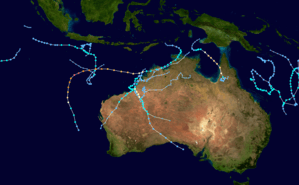Cyclone Marcus
| Category 5 severe tropical cyclone (Aus scale) | |
|---|---|
| Category 5 tropical cyclone (SSHWS) | |
 Marcus at peak intensity well off the Western Australian coast on 22 March | |
| Formed | 14 March 2018 |
| Dissipated | 27 March 2018 |
| (Remnant low after 24 March) | |
| Highest winds |
10-minute sustained: 230 km/h (145 mph) 1-minute sustained: 260 km/h (160 mph) Gusts: 325 km/h (200 mph) |
| Lowest pressure | 912 hPa (mbar); 26.93 inHg |
| Fatalities | None |
| Damage | $75 million (2018 USD)[1] |
| Areas affected | Northern Territory, Western Australia |
| Part of the 2017–18 Australian region cyclone season | |
Severe Tropical Cyclone Marcus was a very powerful tropical cyclone that struck Australia's Northern Territory and the Kimberley region of Western Australia) in March 2018. It was the strongest tropical cyclone of the 2017–18 Australian region cyclone season, as well as the strongest tropical cyclone in the Australian region basin since George in 2007. It was also considered the worst cyclone to hit Darwin since Tracy in 1974.[2]
Meteorological history

On 15 March 2018, a tropical low formed in the western Arafura Sea.[3] Drifting east-southeastwards north of the Tiwi Islands, the tropical low consolidated into a Category 1 tropical cyclone on the Australian scale early on 16 March, and was accordingly given the name Marcus.[4] In a generally favourable environment for intensification, Cyclone Marcus reached Category 2 status in the hours before it crossed the Northern Territory coastline, on 17 March.[5]
Marcus intensified markedly upon moving away from the coast. Soon, the storm started to rapidly intensify and by 21 March, Marcus reached Category 5 intensity.[6] However, after doing so, the storm began to rapidly weaken due to a combination of stronger wind shear and cooler waters.[7] Marcus continued to rapidly weaken as it moves south. The system soon transitioned into an extratropical cyclone on March 25. On March 27, the extratropical remnant of Marcus dissipated.
Preparation and impact
| Rank | Cyclone | Year | Min. pressure |
|---|---|---|---|
| 1 | Mahina* | 1899 | 880 hPa (25.99 inHg)[8] |
| 2 | Gwenda | 1999 | 900 hPa (26.58 inHg) |
| Inigo | 2003 | ||
| 4 | George | 2007 | 902 hPa (26.64 inHg) |
| 5 | Orson | 1989 | 904 hPa (26.70 inHg) |
| 6 | Theodore | 1994 | 910 hPa (26.87 inHg) |
| Vance | 1999 | ||
| Fay | 2004 | ||
| Glenda | 2006 | ||
| 10 | Marcus | 2018 | 912 hPa (26.93 inHg) |
| Source: Australian Bureau of Meteorology | |||


Before the storm, on 15 March, the Australian Bureau of Meteorology issued cyclone warnings for Darwin, the Tiwi Islands and parts of the northwest Top End.[9] Major events and flights in and out of Darwin were cancelled.[10] Approximately 26,000 homes were affected by electricity outages as a result of the destructive winds, even in areas as far south as Batchelor and Adelaide River.[11] Thousands of trees were destroyed across the Greater Darwin region including many African mahoganies planted after Cyclone Tracy for their fast growing and expansive shade qualities.[12][13]
Public schools and non-essential public service agencies were closed while the clean-up efforts continued and tree trunks removed from roads.[11] Cyclone Marcus was the most destructive storm to hit Darwin since Cyclone Tracy caused devastation on Christmas Eve of 1974.[14]
The cleanup response was coordinated by the Northern Territory Emergency Services and included soldiers from the 5th Battalion and local engineers of the Australian Army. The US Marine Rotational Force – Darwin (MRF-D) also contributed to the clean up effort.[15]
Retirement
Due to the damage caused by the cyclone in Darwin and its subsequent intensification, the name Marcus was retired.[16]
See also
- 1897 Darwin cyclone – a cyclone that also caused severe damage in Darwin
- Similarly intense tropical cyclones in the Australian Region:
- Cyclone Inigo (2003)
- Cyclone Gwenda (1999)
- Cyclone Orson (1989)
References
- ↑ "Global Catastrophe Recap April 2018" (PDF). thoughtleadership.aonbenfield.com. Aon Benfield. Retrieved 12 May 2018.
- ↑ "Cyclone Marcus the worst since Tracy". NT News. 20 March 2018. Retrieved 21 March 2018.
- ↑ Tropical Cyclone Technical Bulletin at 1430 UTC 15/03/2018 (Report). Australian Bureau of Meteorology. Archived from the original on 15 March 2018. Retrieved 22 March 2018.
- ↑ Tropical Cyclone Technical Bulletin at 0202 UTC 16/03/2018 (Report). Australian Bureau of Meteorology. Archived from the original on 16 March 2018. Retrieved 22 March 2018.
- ↑ "Media Release - Bureau of Meteorology Newsroom". media.bom.gov.au.
- ↑ "Cyclone Marcus has hit category five and is heading for Perth, but you don't need to panic". ABC News. 21 March 2018.
- ↑ "Tropical Cyclone Marcus". Storm Science Australia. Retrieved 25 May 2018.
- ↑ Kerr, Jack (26 December 2014). "Tropical Cyclone Mahina: Bid to have deadly March 1899 weather event upgraded in record books". Australian Broadcasting Corporation. Archived from the original on 2 April 2015. Retrieved 6 March 2015.
- ↑ "Media Release - Bureau of Meteorology Newsroom". media.bom.gov.au.
- ↑ Butt, Phillippa; Dunlop, Craig (16 March 2018). "Cyclone Marcus causes NTFL Grand Final to be postponed". The Daily Telegraph. Retrieved 21 March 2018.
- 1 2 "Tropical Cyclone Marcus - Update #12 | NTPFES". www.pfes.nt.gov.au.
- ↑ "Tropical Cyclone Marcus – Clean up – Update #11 | NTPFES". www.pfes.nt.gov.au.
- ↑ Palin, Megan (13 January 2015). "Post-cyclone plantings now wreaking havoc". NT News. Retrieved 21 March 2018.
- ↑ Breen, Jacqueline; Vanovac, Neda; Wellington, Shanhi (21 March 2018). "Ants, snakes, and bone-chilling howls: Cyclone Marcus questions answered". ABC News.
- ↑ Smith, Emily; Vanovac, Neda (19 March 2018). "Tropical Cyclone Marcus clean-up continues, residents remains without power". Australia Broadcasting Corporation. ABC News. Retrieved 21 March 2018.
- ↑ "REVIEW OF THE 2016/2017 AND 2017/2018 CYCLONE SEASONS" (PDF). World Meteorological Organization. 26 July 2018. Retrieved 16 September 2018.
External links
| Wikimedia Commons has media related to Cyclone Marcus. |
